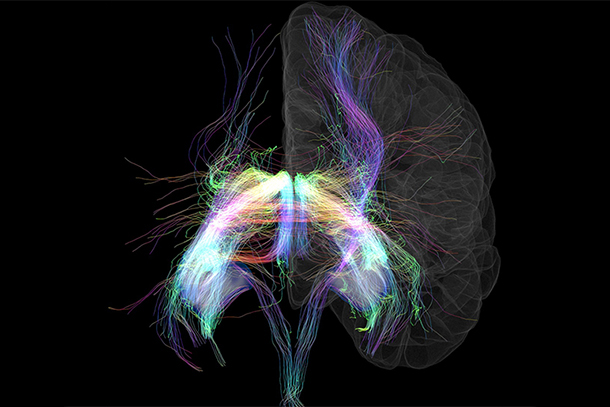In fiscal year 2017-2018, the USC Mark and Mary Stevens Neuroimaging and Informatics Institute (INI) at the Keck School of Medicine of USC received more than $30.5 million in active research funding. This summer, the institute added millions more in federal grants for ongoing projects exploring Alzheimer’s disease, mapping connectivity in the brainstem and building a new archive to facilitate nationwide data sharing. Selected projects are highlighted here.
Data Archive for the BRAIN Initiative (DABI)
INI joined the BRAIN Initiative, a prestigious public-private partnership led by the National Institutes of Health (NIH) that aims to develop and apply technologies to revolutionize the study of the human brain, in 2017 with a $19 million grant to Hongwei Dong, MD, PhD. Now, the institute will double down on its role in the program with a five-year, $5.38 million grant to design and build a shared repository for invasive human neurophysiology data collected by BRAIN Initiative investigators.
Invasive neurophysiology data includes intracranial electroencephalography, or EEG, which is electrical data collected using electrodes implanted inside the brain, as well as several other types of electrophysiological data. The technology holds promise for conditions such as treatment-resistant depression, Parkinson’s disease and epilepsy. The archive will also accommodate data from MRI scans, PET scans and behavioral and clinical assessments in order to create a more complete picture of the human brain in health and disease.
“Our institute is committed to facilitating data sharing across the neuroscience research community,” said Arthur W. Toga, PhD, director of INI and PI for the project; Dominique Duncan, PhD, and Nader Pouratian, MD, PhD, of UCLA are co-PIs. “DABI is our latest effort to expand our current repositories to accommodate new investigations and data types.”
DABI builds on INI’s success creating large-scale informatics solutions — for Parkinson’s disease research, via the Parkinson’s Progression Markers Initiative (PPMI) and Alzheimer’s disease data, via the Alzheimer’s Disease Neuroimaging Initiative (ADNI) — which have evolved over several decades into some of the most widely-used informatics resources in neuroscience. The new archive will ingest, harmonize, aggregate, store, visualize and disseminate data. DABI is also specifically designed to help BRAIN Initiative researchers fulfill data-sharing directives from federal agencies and their respective institutions.
Genetic Risk for Disease in the Aging Brain
Neda Jahanshad, PhD, assistant professor of neurology, will launch a five-year effort to map genetic risk for Alzheimer’s and other neurodegenerative diseases. The $3 million grant from NIH will allow her team to examine brain imaging and genetics data from more than 30,000 people, using new mathematical approaches to map differences in the rate of tissue loss.
“What’s new about this is that we’re pairing up with USC’s Information Sciences Institute to make our findings available through an open portal for researchers,” Jahanshad said. “They can query and filter our results, and even add their findings to ours.” She predicts this will help build a more robust understanding of the link between brain change and genetic risk factors.
Jahanshad’s team also received grants to examine brain development, cognitive decline, Parkinson’s disease and suicide risk factors using brain mapping.
Brainstem Connectomes and Alzheimer’s Disease
INI’s Yonggang Shi, PhD, assistant professor of neurology, has received $2.45 million from NIH for a five-year investigation of brainstem connectomes related to Alzheimer’s disease.
“Recent post-mortem studies have shown that some of the earliest and most significant tau pathology in Alzheimer’s disease occurs in the brainstem,” Shi said. That’s why he and his team have decided to look more closely at this ancient part of the brain, which regulates basic functions such as heartrate and sleep.
Shi has been a key contributor to the Human Connectome Project, including creating detailed connectivity maps of vision pathways that have helped researchers better understand low vision and blindness. He says the present project may reveal key insights about Alzheimer’s pathology, but will also be broadly applicable to many other basic functions and diseases of the brain that affect the brainstem.
Brain Activity During the Micturition Cycle
Kay Jann, PhD, assistant professor of research, received a grant from the L.K. Whittier Foundation to work with co-PI Evgeniy Kreydin, MD, assistant professor of clinical neurology. Their pilot project aims to localize the brain regions and activity involved in micturition, or urination, and ultimately to develop a neuromodulation treatment to improves control over bladder function.
“Our overarching goal is to provide a non-invasive treatment option for affected individuals by modulating the activity of brain areas that regulate micturition,” Jann said, adding that the research can help patients who lose control of bladder function due to spinal cord injury, stroke or for other reasons. “This study is a first step, but if successful, it could pave the way to improve the lives of many.”
VEGF’s Relationship to Brain Aging Biomarkers and Cognition
Meral Tubi, a graduate student studying neuroscience, received more than $133,000 from NIH to study how vascular endothelial growth factor (VEGF), a protein that triggers blood vessel growth, is involved with brain health and Alzheimer’s disease.
“Our study is the first to investigate how certain biological stressors common in older adults may alter how VEGF affects cognitive aging,” Tubi said. “This project will help clarify the relationship of VEGF to Alzheimer’s risk, and may focus future research on the treatment potential of this protein.”
— Zara Greenbaum


